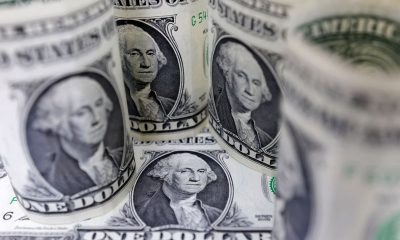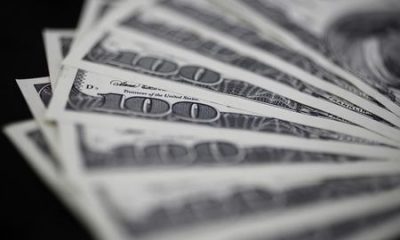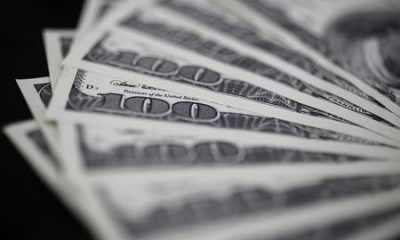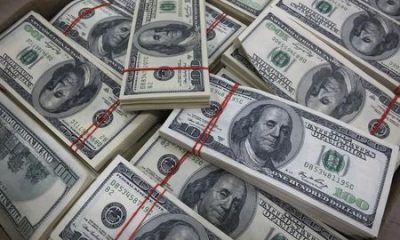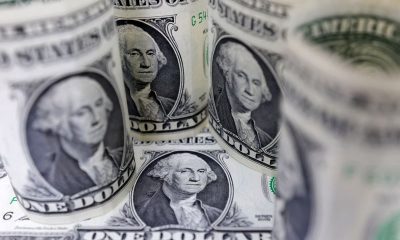Economy
Bank of Canada holds rates, says path to avoid recession narrower
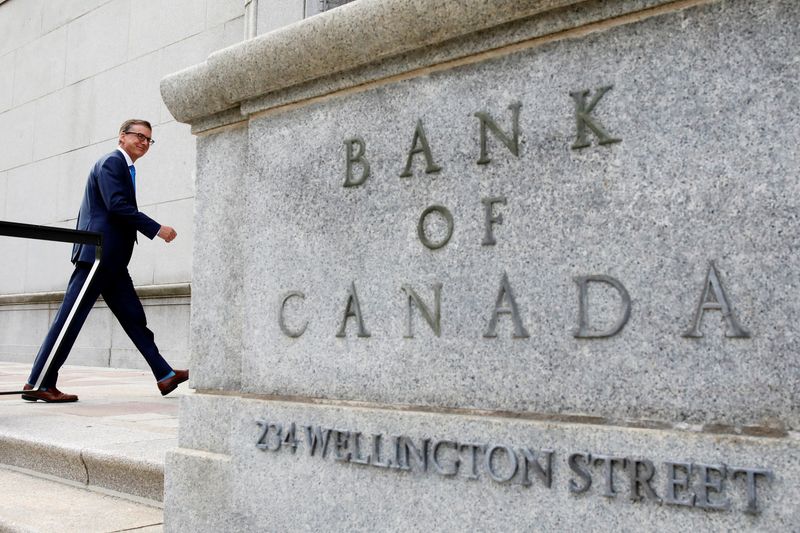
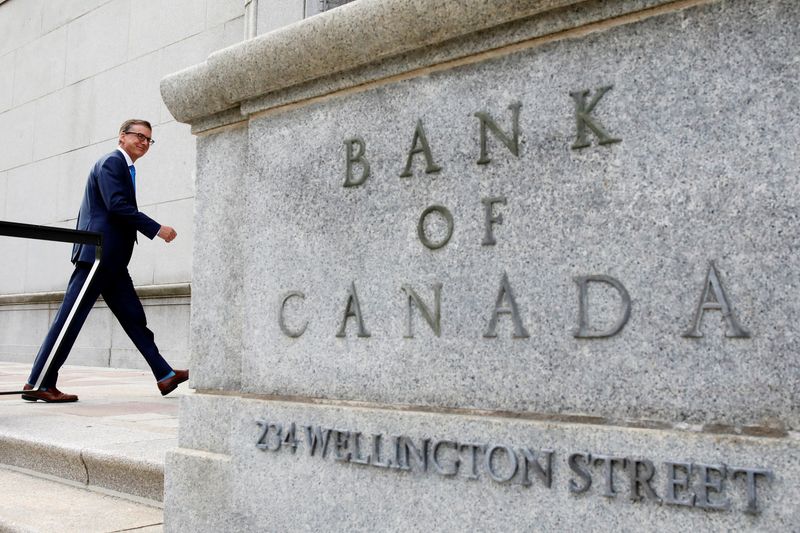
© Reuters. FILE PHOTO: Governor of the Bank of Canada Tiff Macklem walks outside the Bank of Canada building in Ottawa, Ontario, Canada June 22, 2020. REUTERS/Blair Gable/File Photo
By Steve Scherer and David Ljunggren
OTTAWA (Reuters) -The Bank of Canada (BoC) on Wednesday held its key overnight rate at 5.0% as expected and said the path to avoid a recession had narrowed, while leaving the door open to more rate hikes to tame inflation that could exceed its target for another two years.
The bank increased rates 10 times between March 2022 and this July, with inflation peaking at more than 8% last year. Inflation in September dipped to 3.8% from 4.0% in August, and the central bank said it would average 3.5% through mid-2024.
Inflation is expected to return to the 2% target by the end of 2025, slightly later than July’s forecast of mid-2025, “but the near-term path is higher because of energy prices and ongoing persistence in core inflation,” the BoC said.
“Progress towards prices stability is slow and inflationary risks have increased,” it said, reiterating language from previous policy decisions that it is still prepared to raise rates further if needed.
Inflation will decline to around 2.5% in the second half of 2024, the bank said.
“We’ve made a lot of progress, but we’re not there yet,” BoC Governor Tiff Macklem told reporters.
The BoC is “really driving home the point that they still have a tightening bias and any significant, upside surprise on growth or inflation could be met with further rate hikes and I think that’s about the appropriate stance to take,” said Doug Porter, chief economist at BMO Capital Markets.
On the dovish side, gross domestic product is seen rising at an annualized rate of 0.8% in both the third and fourth quarters of 2023. The BoC in July forecast third-quarter annualized growth of 1.5%.
The BoC cut its 2023 growth estimate to 1.2% from 1.8% in July and said 2024 growth would be 0.9%, down from a previously forecast 1.2%. The global economy is slowing and a recent surge in global bond yields is weighing on demand, the bank said.
“The path to a soft landing is narrow, and in this projection, that path has gotten narrower,” Macklem said.
The Canadian dollar weakened to a seven-month low at 1.3795 per U.S. dollar, or 72.49 U.S. cents, down as much as 0.4% on the day.
“There is growing evidence that past interest rate increases are dampening economic activity and relieving price pressures,” the BoC said in a statement. “A range of indicators suggest that supply and demand in the economy are now approaching balance.”
Wages continued to grow between 4% and 5% annually and core inflation measures have shown “little downward momentum,” the bank said.
“Given this sort of dovish tone around the economy, it feels like it would be difficult to see the BoC change their direction quick enough to do anything in December,” said Andrew Kelvin, chief Canada strategist at TD Securities.
Among the risks cited were oil prices, which are higher than had been assumed in July, and the war in Israel and Gaza, which adds to geopolitical uncertainty, the BoC said.
The central bank is probably done raising rates and will hold them at a 22-year high of 5.0% for at least six months, according to a Reuters poll of economists published on Friday.
Money markets now price in a 14% chance of a rate hike in December.
Economy
Russian central bank says it needs months to make sure CPI falling before rate cuts -RBC


© Reuters. Russian Central Bank Governor Elvira Nabiullina attends a news conference in Moscow, Russia June 14, 2019. REUTERS/Shamil Zhumatov/File Photo
MOSCOW (Reuters) – Russia’s central bank will need two to three months to make sure that inflation is steadily declining before taking any decision on interest rate cuts, the bank’s governor Elvira Nabiullina told RBC media on Sunday.
The central bank raised its key interest rate by 100 basis points to 16% earlier in December, hiking for the fifth consecutive meeting in response to stubborn inflation, and suggested that its tightening cycle was nearly over.
Nabiullina said it was not yet clear when exactly the regulator would start cutting rates, however.
“We really need to make sure that inflation is steadily decreasing, that these are not one-off factors that can affect the rate of price growth in a particular month,” she said.
Nabiullina said the bank was taking into account a wide range of indicators but primarily those that “characterize the stability of inflation”.
“This will take two or three months or more – it depends on how much the wide range of indicators that characterize sustainable inflation declines,” she said.
The bank will next convene to set its benchmark rate on Feb. 16.
The governor also said the bank should have started monetary policy tightening earlier than in July, when it embarked on the rate-hiking cycle.
Economy
China identifies second set of projects in $140 billion spending plan


© Reuters. FILE PHOTO: Workers walk past an under-construction area with completed office towers in the background, in Shenzhen’s Qianhai new district, Guangdong province, China August 25, 2023. REUTERS/David Kirton/File Photo
SHANGHAI (Reuters) – China’s top planning body said on Saturday it had identified a second batch of public investment projects, including flood control and disaster relief programmes, under a bond issuance and investment plan announced in October to boost the economy.
With the latest tranche, China has now earmarked more than 800 billion yuan of its 1 trillion yuan ($140 billion) in additional government bond issuance in the fourth quarter, as it focuses on fiscal steps to shore up the flagging economy.
The National Development and Reform Commission (NDRC) said in a statement on Saturday it had identified 9,600 projects with planned investment of more than 560 billion yuan.
China’s economy, the world’s second largest, is struggling to regain its footing post-COVID-19 as policymakers grapple with tepid consumer demand, weak exports, falling foreign investment and a deepening real estate crisis.
The 1 trillion yuan in additional bond issuance will widen China’s 2023 budget deficit ratio to around 3.8 percent from 3 percent, the state-run Xinhua news agency has said.
“Construction of the projects will improve China’s flood control system, emergency response mechanism and disaster relief capabilities, and better protect people’s lives and property, so it is very significant,” the NDRC said.
The agency said it will coordinate with other government bodies to make sure that funds are allocated speedily for investment and that high standards of quality are maintained in project construction.
($1 = 7.1315 renminbi)
Economy
Russian central bank says it needs months to make sure CPI falling before rate cuts -RBC


© Reuters. Russian Central Bank Governor Elvira Nabiullina attends a news conference in Moscow, Russia June 14, 2019. REUTERS/Shamil Zhumatov/File Photo
MOSCOW (Reuters) – Russia’s central bank will need two to three months to make sure that inflation is steadily declining before taking any decision on interest rate cuts, the bank’s governor Elvira Nabiullina told RBC media on Sunday.
The central bank raised its key interest rate by 100 basis points to 16% earlier in December, hiking for the fifth consecutive meeting in response to stubborn inflation, and suggested that its tightening cycle was nearly over.
Nabiullina said it was not yet clear when exactly the regulator would start cutting rates, however.
“We really need to make sure that inflation is steadily decreasing, that these are not one-off factors that can affect the rate of price growth in a particular month,” she said.
Nabiullina said the bank was taking into account a wide range of indicators but primarily those that “characterize the stability of inflation”.
“This will take two or three months or more – it depends on how much the wide range of indicators that characterize sustainable inflation declines,” she said.
The bank will next convene to set its benchmark rate on Feb. 16.
The governor also said the bank should have started monetary policy tightening earlier than in July, when it embarked on the rate-hiking cycle.

 Forex2 years ago
Forex2 years agoForex Today: the dollar is gaining strength amid gloomy sentiment at the start of the Fed’s week

 Forex2 years ago
Forex2 years agoHow is the Australian dollar doing today?

 Forex1 year ago
Forex1 year agoUnbiased review of Pocket Option broker

 Forex2 years ago
Forex2 years agoDollar to pound sterling exchange rate today: Pound plummeted to its lowest since 1985

 Cryptocurrency2 years ago
Cryptocurrency2 years agoWhat happened in the crypto market – current events today

 World2 years ago
World2 years agoWhy are modern video games an art form?

 Stock Markets2 years ago
Stock Markets2 years agoMorgan Stanley: bear market rally to continue

 Economy2 years ago
Economy2 years agoCrude oil tankers double in price due to EU anti-Russian sanctions

